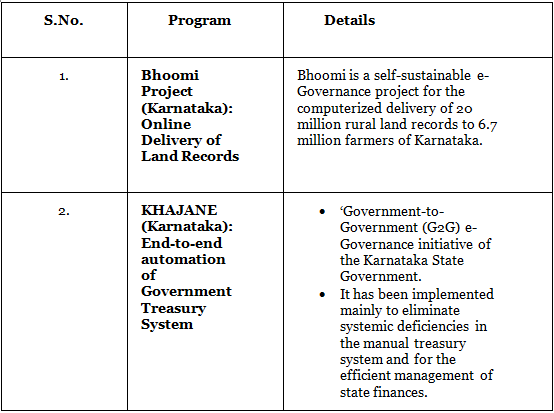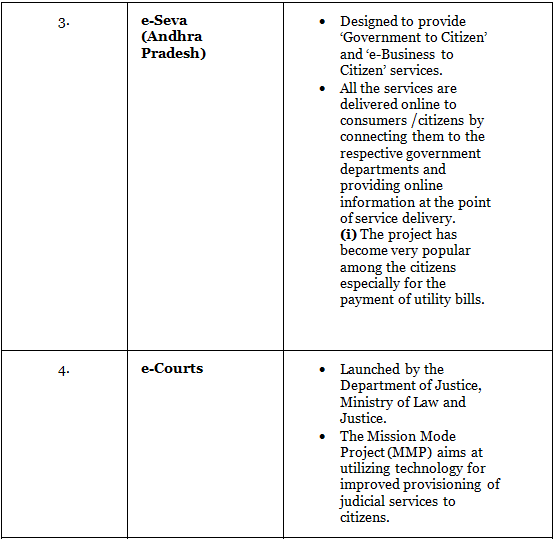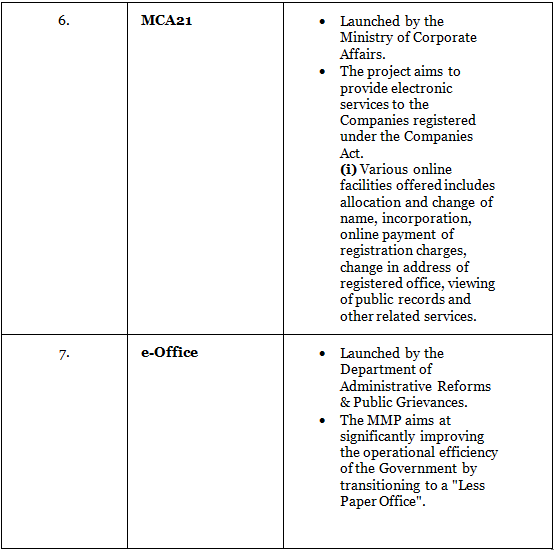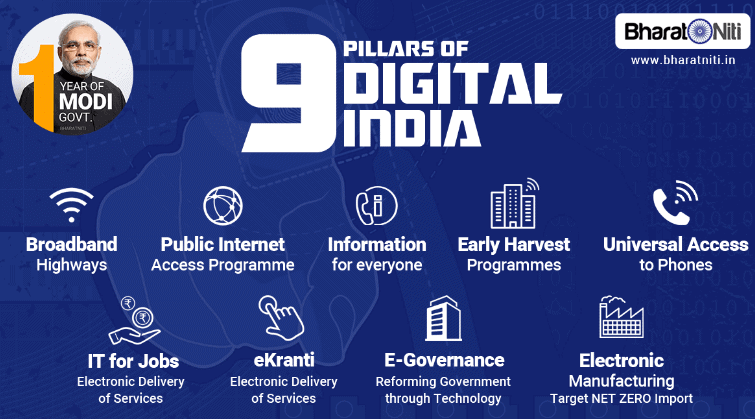UPSC Exam > UPSC Notes > Science & Technology for UPSC CSE > E-Governance
E-Governance | Science & Technology for UPSC CSE PDF Download
Introduction
- e-Governance can be defined as the application of information and communication technology (ICT) for providing government services, exchange of information, transactions, integration of previously existing services and information portals.
- The “e” in e-Governance stands for ‘electronic’.
The Council of Europe referred to e-Governance as:
- The use of electronic technologies in three areas of public action:
- relations between the public authorities and civil society
- the functioning of the public authorities at all stages of the democratic process (electronic democracy)
- the provision of public services (electronic public services)
Reasons for Opting e-Governance
- Governance per se has become very complex
- Increase in citizens’ expectations from the government
Different Connotations of e-Governance
- e-Administration: The use of ICTs to modernize the state; the creation of data repositories for Management Information System (MIS) and computerization of records (land, health etc).
- e-Services: The emphasis here is to bring the state closer to the citizens.
- For Examples: Provision of online services.
- e-administration and e-services together constitute what is largely termed as e-government.
- e-Governance: The use of IT to improve the ability of the government to address the needs of society.
- It includes the publishing of policy and program-related information to transact with citizens.
- It extends beyond the provision of online services and covers the use of IT for strategic planning and reaching the development goals of the government.
- e-Democracy: The use of IT to facilitate the ability of all sections of society to participate in the governance of the state.
- Emphasis is on bringing transparency, accountability, and participation of people.
- It includes online disclosures of policies, online grievance redressal, e-referendums etc.
Origin
- e-Governance originated in India during the 1970s with a focus on in-house government applications in the areas of defence, economic monitoring, planning and deployment of ICT to manage data intensive functions related to elections, census, tax administration etc.
Initial Steps Taken
- The establishment of the Department of Electronics in 1970 was the first major step towards e-governance in India as it brought ‘information’ and its communication to focus.
- National Informatics Centre (NIC) established in 1977, launched the District Information System program to computerize all district offices in the country
- The main thrust for e-governance was provided by the launching of NICNET in 1987 – the national satellite-based computer network.
Objectives
- Better service delivery to citizens.
- Ushering in transparency and accountability.
- Empowering people through information.
- Improve efficiency within Government i.e between centre-state or inter-states.
- Improve interface with business and industry.
Pillars of e-Governance
- People
- Process
- Technology
- Resources
Types of Interaction in e-Governance
- G2G i.e. Government to Government
- G2C i.e. Government to Citizen
- G2B i.e. Government to Business
- G2E i.e. Government to Employees
Initiatives Taken for e-Governance in India




Digital India Initiatives
- It is an umbrella program to prepare India for a knowledge-based transformation.
- It weaves together a large number of ideas and thoughts into a single comprehensive vision so that each of them is seen as part of a larger goal.
- It has been launched by the Ministry of Electronics and Information Technology (Meity).
Vision Areas
- Digital infrastructure as Utility to Every Citizen
- Governance and services on demand
- Digital empowerment of citizens

9 pillars of digital India
Various Initiatives Under Digital India Initiatives
- MyGov: It aims to establish a link between Government and Citizens towards meeting the goal of good governance.
- It encourages citizens as well as people abroad to participate in various activities i.e. 'Do', 'Discuss', 'Poll', 'Talk', ‘Blog’, etc.
- DigiLocker: It serves as a platform to enable citizens to securely store and share their documents with service providers who can directly access them electronically.
- e-Hospital-Online Registration Framework (ORF): It is an initiative to facilitate the patients to take online OPD appointments with government hospitals. This framework also covers patient care, laboratory services and medical record management.
- National Scholarships Portal (NSP): It provides a centralized platform for application and disbursement of scholarship to students under any scholarship scheme.
- DARPAN: It is an online tool that can be used to monitor and analyze the implementation of critical and high priority projects of the State.
- It facilitates presentation of real time data on Key Performance Indicators (KPIs) of selected schemes/projects to the senior functionaries of the State Government as well as district administration.
- PRAGATI (Pro-Active Governance and Timely
Implementation: It has been aimed at starting a culture of Pro-Active Governance and Timely Implementation.- It is also a robust system for bringing e-transparency and e-accountability with real-time presence and exchange among the key stakeholders.
- It was launched in 2015.
- Common Services Centres 2.0 (CSC 2.0): It is being implemented to develop and provide support to the use of information technology in rural areas of the country.
- The CSCs are Information and Communication Technology (ICT) enabled kiosks with broadband connectivity to provide various Governments, private and social services at the doorstep of the citizen.
- Mobile Seva: It provides government services to the people through mobile phones and tablets.
- Jeevan Pramaan: It is an Aadhaar based Biometric Authentication System for Pensioners.
- The system provides authenticity to Digital Life Certificate without the necessity of the pensioner being present in person before his/ her Pension Dispensing Authority (PDA).
- National Centre of Geo-informatics (NCoG): Under this project, Geographic Information System (GIS) platform for sharing, collaboration, location based analytics and decision support system for Departments has been developed.
- National e-Governance Plan (NeGP): It takes a holistic view of e-Governance initiatives across the country, integrating them into a collective vision and a shared cause.
- It comprises of 31 Mission Mode Projects, approved in 2006, but later it was integrated into Digital India Program.
e-Kranti: National e-Governance Plan 2.0
- It is an essential pillar of the Digital India initiative.
- It was approved in 2015 with the vision of “Transforming e-Governance for Transforming Governance”.
- There are 44 Mission Mode Projects under e-Kranti, which are at various stages of implementation.
Thrust Areas of e-Kranti
- e-Education: All schools will be connected to broadband. Free WiFi will be provided in all secondary and higher secondary schools (coverage would be around 250,000 schools).
- PMGDISHA: Pradhan Mantri Gramin Digital Saksharta Abhiyaan aims to make six crore people in rural India digitally literate.
- SWAYAM: It includes Massive Online Open Courses (MOOCs) for leveraging e-Education. It provides for a platform that facilitates hosting of all the courses, taught in classrooms from Class 9 till post-graduation to be accessed by anyone, anywhere at any time.
- e-Healthcare: e-Healthcare would cover online medical consultation, online medical records, online medicine supply, pan-India exchange for patient information, etc.
- Farmers: This would facilitate farmers to get real-time price information, online ordering of inputs and online cash, loan, and relief payment with mobile banking.
- Security: Mobile-based emergency services and disaster-related services would be provided to citizens on a real-time basis so as to take precautionary measures well in time and minimize loss of lives and properties.
- Financial Inclusion: Financial inclusion shall be strengthened using mobile banking, Micro-ATM program, and CSCs/ Post Offices.
- Justice: Interoperable Criminal Justice System shall be strengthened by leveraging several related applications, i.e. e-Courts, e-Police, e-Jails, and e-Prosecution.
- Planning: National GIS Mission Mode Project would be implemented to facilitate GIS-based decision making for project planning, conceptualization, design, and development.
- Cyber Security: National Cyber Security Co-ordination Centre has been set up to ensure a safe and secure cyber-space within the country.
Benefits/ Outcomes of E-Governance
- Enhanced Transparency and Accountability.
- Expanded reach of Governance.
- Improved Public Administration.
- Enables Environment for Promoting Economic development.
- Improved service delivery in the form of better access to information and quality services to citizens.
Challenges to E-Governance
 Issues related to e-Governance
Issues related to e-Governance
- Infrastructure
- Lack of basic infrastructural facilities like electricity, internet, etc.
- Initiatives like BharatNet and Saubhagya are steps taken in this regard.
- Cost
- e-Governance measures are costly affairs and require huge public expenditure.
- In developing countries like India, the cost of projects is one of the major impediments in the implementation of e-Governance initiatives.
- Privacy and Security
- Recent spark in data leak cases has threatened the peoples’ faith in e-governance. Therefore, the implementation of e-governance projects must have security standards and protocols for safeguarding the interest of all classes of masses.
- Digital Divide
- Huge gap between users and non-users of e-govt. services.
- The digital divide takes form in rich-poor, male-female, urban-rural etc segments of the population.
- The gap needs to be narrowed down, then only the benefits of e-governance would be utilized equally.
Suggestions
- A hybrid approach needs to be adopted for enhancing interoperability among e-governance applications which will encompass a centralized approach for document management, knowledge management, file management, grievance management etc.
- The e-governance initiatives in rural areas should be taken by identifying and analyzing the grassroots realities.
- The government should also focus on devising appropriate, feasible, distinct and effective capacity building mechanisms for various stakeholders viz bureaucrats, rural masses, urban masses, elected representatives, etc.
- Cloud computing is also becoming a big force to enhance the delivery of services related to e-governance. Cloud computing is not only a tool for cost reduction but also helps in enabling new services, improving the education system and creating new jobs/ opportunities.
- Meghraj- GI Cloud is a step in the right direction. The focus of this initiative is to accelerate the delivery of e-services in the country while optimizing ICT spending of the Government.
- e-Governance through regional languages is appreciable for the nations like India where people from several linguistic backgrounds are the participants.
Conclusion
- e-Governance is getting momentum in India, but public awareness and the digital divide are important issues to be addressed.
- The success of e-Governance measures largely depends on the availability of high-speed internet, and the nation-wide roll-out of 5G technology in the near future will strengthen our resolve.
The document E-Governance | Science & Technology for UPSC CSE is a part of the UPSC Course Science & Technology for UPSC CSE.
All you need of UPSC at this link: UPSC
|
133 videos|399 docs|221 tests
|
FAQs on E-Governance - Science & Technology for UPSC CSE
| 1. What is e-governance? |  |
Ans. E-governance refers to the use of electronic communication and information technology in the administration and operation of government services. It aims to improve efficiency, transparency, and accessibility of government processes.
| 2. How does e-governance benefit citizens? |  |
Ans. E-governance benefits citizens by providing them with convenient access to government services, reducing bureaucratic delays, improving transparency and accountability, and enabling participation in decision-making processes.
| 3. What are some examples of e-governance initiatives? |  |
Ans. Examples of e-governance initiatives include online tax filing systems, digital identity cards, electronic voting systems, government portals for accessing information and services, and online complaint and grievance redressal systems.
| 4. How does e-governance ensure data security and privacy? |  |
Ans. E-governance ensures data security and privacy through the implementation of robust encryption techniques, secure networks, and strict access controls. It also includes measures to safeguard personal information and comply with data protection laws.
| 5. What are the challenges in implementing e-governance? |  |
Ans. Some challenges in implementing e-governance include inadequate technology infrastructure, digital divide among citizens, resistance to change, cybersecurity threats, and ensuring the inclusivity of marginalized sections of society.
|
133 videos|399 docs|221 tests
|
Download as PDF

|
Explore Courses for UPSC exam
|

|
Signup for Free!
Signup to see your scores go up within 7 days! Learn & Practice with 1000+ FREE Notes, Videos & Tests.
Related Searches


















